If you’re looking for the 8 best math art coloring books that make learning fun and creative, I recommend titles that combine engaging designs with educational content, like geometric patterns, fractals, and tessellations. Many feature clear explanations to enhance understanding while providing relaxing activities. Whether for young children or older learners, these books balance visual variety and educational depth. Keep exploring, and you’ll discover how each one can turn math practice into a colorful adventure.
Key Takeaways
- The collection features diverse artistic styles like geometric patterns, fractals, and tessellations to engage different interests.
- Many books combine colorful visuals with educational explanations to reinforce math concepts creatively.
- Designed for various age groups, from early learners to adults, offering appropriate complexity and skill levels.
- High-quality paper and printing ensure durability and prevent bleed-through during coloring activities.
- Incorporating fun activities like storytelling and coloring boosts motivation, making math learning enjoyable and stress-free.
Discover Mathematics with Master MINT – 60 Exciting Stories and Coloring Fun for Young Explorers
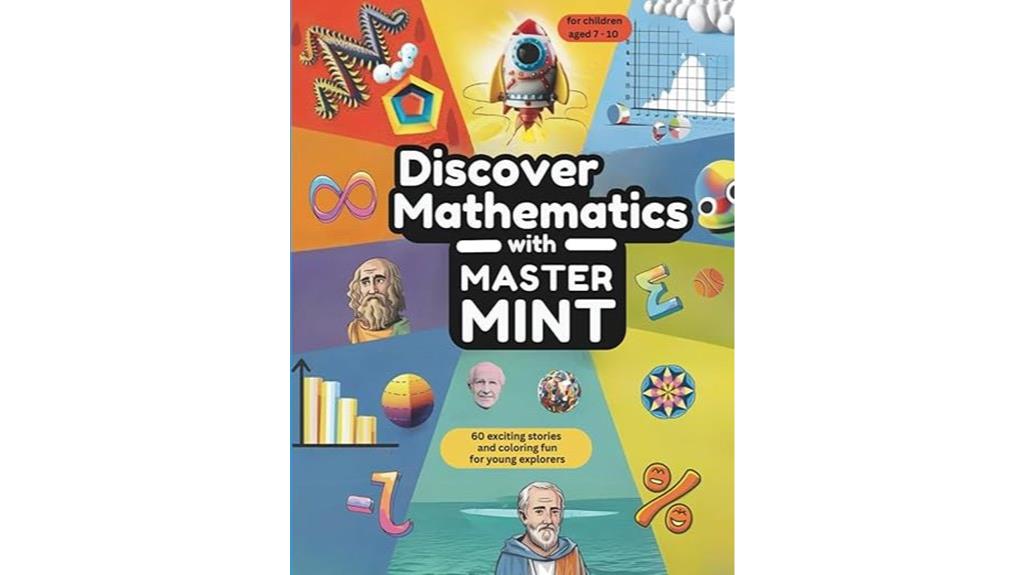
Are you looking for a way to make math fun and engaging for kids aged 7 to 10? Discover Mathematics with Master MINT is an incredible coloring book that combines storytelling with creative activities. It features 60 stories that explain key math concepts like geometry and algebra through relatable human stories, making complex ideas easier to grasp. The coloring activities add a calming, hands-on element that reinforces learning without feeling intimidating. I’ve seen kids become excited about math after exploring these stories and coloring pages. This book truly turns math into an adventure, inspiring curiosity and making learning enjoyable for young explorers.
Best For: young children aged 7-10 who are curious about math and enjoy creative, hands-on learning experiences.
Pros:
- Engages children with fun stories that make complex math concepts like algebra and geometry accessible.
- Combines storytelling with coloring activities to reinforce learning in a calming, imaginative way.
- Inspires enthusiasm for math, transforming it from intimidating to enjoyable and relatable.
Cons:
- May require adult guidance for younger children to fully understand some concepts.
- Coloring activities might not appeal to children who prefer purely academic learning.
- Limited focus on advanced topics, so older or more experienced learners might find it less challenging.
Patterns of the Universe: A Coloring Adventure in Math and Beauty
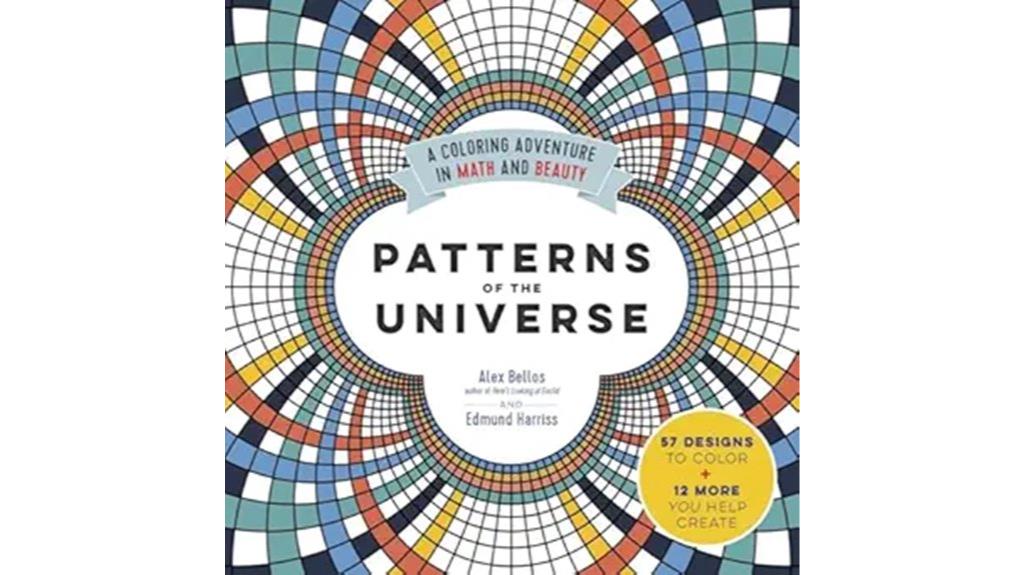
Patterns of the Universe: A Coloring Adventure in Math and Beauty stands out as an ideal choice for anyone fascinated by the visual beauty of mathematical concepts. I love how it combines intricate geometric patterns with educational insights, making learning both fun and relaxing. The designs range from tessellations to fractals, each showcasing math’s artistic side. I appreciate the brief explanations that deepen understanding without overwhelming me. The calming activity helps reduce stress, and I enjoy challenging myself with detailed patterns. Although the paper isn’t perfect for markers, I find colored pencils work beautifully. This book truly brings math’s beauty to life through creative coloring.
Best For: individuals who love exploring the visual beauty of mathematical patterns through relaxing and educational coloring activities.
Pros:
- Combines artistic pattern creation with educational insights into math concepts like fractals and tessellations.
- Provides a calming activity that helps reduce stress and anxiety.
- Features a variety of designs from simple to intricate, catering to different skill levels.
Cons:
- The paper quality is average and may bleed through with markers, requiring precautions.
- The book is smaller than standard coloring books, which might be less ideal for detailed work.
- Some users find the explanations brief and wish for more in-depth educational content.
The Golden Ratio Coloring Book

The Golden Ratio Coloring Book stands out for anyone fascinated by the intersection of art and mathematics, offering intricate designs inspired by tessellations, fractals, and sacred geometry. I love how each page combines beauty with educational value, with explanations of concepts like the Golden Ratio that deepen understanding while I color. The heavy, bright white paper handles markers well, though I prefer coloring on one side to prevent bleed-through. The detailed patterns provide hours of relaxing, meditative fun, making it perfect for stress relief or learning. Overall, it’s a unique blend of creativity and math, making it a thoughtful gift for curious minds.
Best For: individuals who love exploring the beauty of mathematical patterns through detailed coloring, as well as those seeking relaxation and educational insights into the Golden Ratio and sacred geometry.
Pros:
- Beautiful, intricate designs inspired by tessellations, fractals, and sacred geometry that offer hours of coloring fun
- High-quality, heavy white paper suitable for markers and various coloring media without bleed-through
- Combines artistic creativity with educational explanations, enhancing understanding of mathematical concepts
Cons:
- Pages are printed on both sides, which may cause bleed-through unless coloring on one side only
- Not perforated, making it difficult to remove pages for display or individual use
- Some users find the mathematical explanations too simplified or not as detailed as they would like
Double Digit Addition and Subtraction Color by Number Math Coloring Book
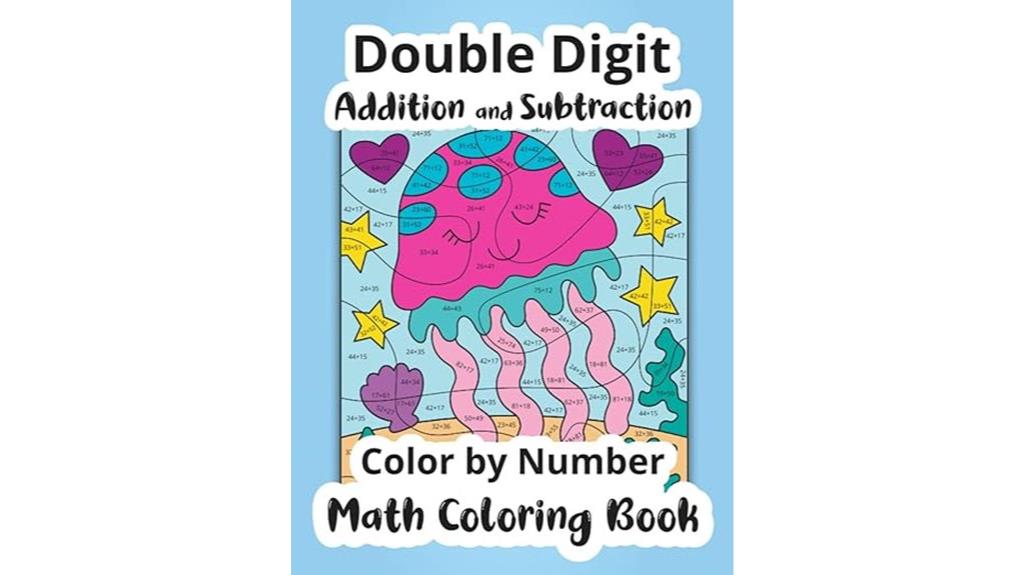
For parents and educators seeking engaging ways to reinforce double-digit addition and subtraction, the Double Digit Addition and Subtraction Color by Number Math Coloring Book stands out as an excellent choice. I’ve seen how it helps autistic children develop math skills while keeping them motivated through coloring. The creative approach combines learning with artistic expression, making math enjoyable. Designed for third graders who already understand these concepts, it offers a fun way to reinforce skills. Many parents report quick completion and increased enthusiasm, with children practicing and mastering double-digit math within just two weeks. It’s a proven method to make learning both effective and fun.
Best For: parents and educators seeking a fun, engaging way to reinforce double-digit addition and subtraction skills with third-grade children, especially those with autism or learning difficulties.
Pros:
- Encourages math practice through creative coloring activities, increasing motivation and engagement.
- Suitable for children who have already learned basic double-digit addition and subtraction, reinforcing their skills effectively.
- Quick to complete, with many children finishing the activities within two weeks, demonstrating effective learning and retention.
Cons:
- May require adult supervision to ensure children stay focused and correctly complete the activities.
- Designed specifically for double-digit addition and subtraction, so it may not be suitable for students at earlier learning stages.
- The coloring aspect might be less appealing to children who prefer more traditional or digital learning tools.
ABC Dot Art Coloring Book for Kids Ages 2-5
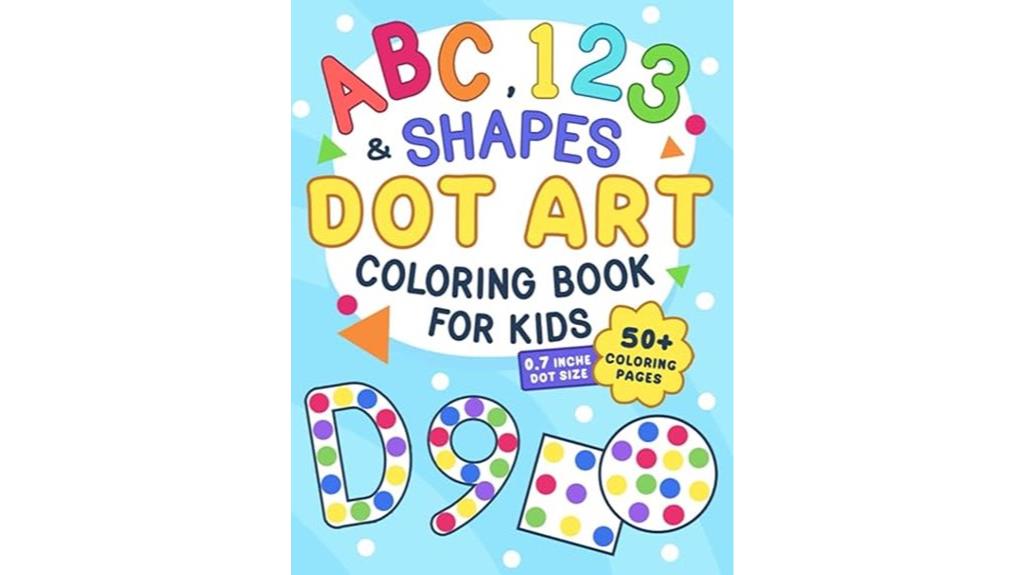
Looking for a fun and educational activity for your preschooler? The ABC Dot Art Coloring Book for Kids Ages 2-5 is perfect. It features engaging dot art designs that teach the alphabet, numbers, and shapes through creative activities. Designed for little hands, it keeps kids entertained while supporting early learning skills. Parents and teachers rave about its durability and educational value, though some note minor bleed-through with markers. Overall, it’s a versatile tool for fostering preschoolers’ cognitive development, making learning both fun and hands-on. This book is a fantastic way to introduce foundational concepts in a playful, colorful way.
Best For: parents, teachers, and caregivers seeking a fun, educational activity to support preschoolers’ early learning of the alphabet, numbers, and shapes through engaging dot art designs.
Pros:
- Encourages early childhood education with interactive and creative activities
- Made with durable, high-quality materials suitable for young children
- Highly recommended by parents and educators for fun, skill-building entertainment
Cons:
- Some pages may bleed through when using certain markers
- Designed primarily for ages 2-5, limiting use for older children
- Limited variety in art styles, focusing mainly on dot designs
Color by Math Workbook for Kids Ages 8-12
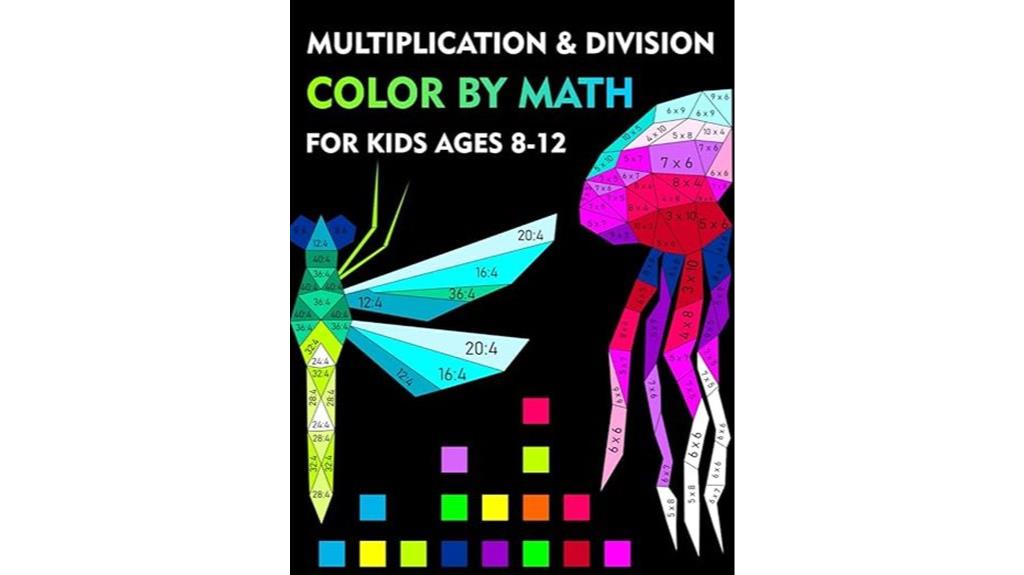
If you’re searching for a fun way to boost your child’s multiplication and division skills, the Color by Math Workbook for Kids Ages 8-12 stands out as an excellent choice. It offers engaging practice with multiplication tables through colorful, enjoyable activities that keep kids focused and help improve retention. Many parents and teachers see it as an effective tool for reinforcing math concepts, especially for children who struggle. With appealing illustrations of animals and themes, it makes math practice inviting. Kids often enjoy working on it independently or with family, transforming learning into a creative, rewarding experience that combines education with fun.
Best For: children aged 8-12 who love math and coloring, especially those needing extra practice with multiplication and division concepts.
Pros:
- Engages children with colorful illustrations that make learning fun and visually appealing.
- Helps improve multiplication and division skills through interactive activities.
- Promotes independent learning and creativity, making math practice less tedious.
Cons:
- Some users find the color contrast could be improved for easier guessing and coloring.
- The workbook may arrive bent or slightly damaged, affecting initial presentation.
- Initial perceptions of the workbook resembling homework might reduce enthusiasm at first.
Visions of the Universe: A Coloring Journey Through Math’s Great Mysteries
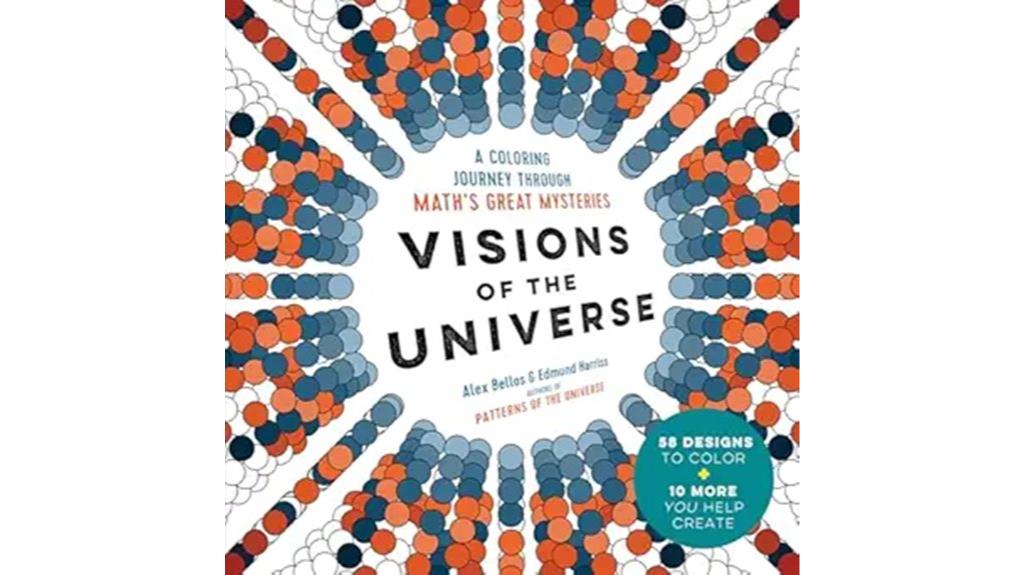
Visions of the Universe stands out as an ideal choice for anyone fascinated by the intersection of math and art, especially those enthusiastic to explore complex ideas through visually engaging images. This coloring book features high-quality printing, durable pages, and stunning artwork that makes learning both beautiful and meaningful. Each page showcases mathematical discoveries like fractals and patterns, paired with clear explanations that make complex concepts accessible. The intricate designs blend artistic creativity with scientific insight, inspiring curiosity and deepening understanding. Whether for casual coloring or educational exploration, this book offers a compelling journey into math’s great mysteries, making it a treasured keepsake and learning tool.
Best For: Enthusiasts and learners of all ages who are interested in exploring the beauty of math through artistic coloring and educational insights.
Pros:
- High-quality printing, durable pages, and stunning original artwork.
- Combines artistic patterns with clear explanations of complex mathematical concepts.
- Suitable for a broad audience, from children to adults, fostering creativity and understanding.
Cons:
- Some users prefer black-and-white designs for more traditional coloring experiences.
- The detailed images may be challenging for younger children or beginner colorers.
- Pages should be handled carefully to preserve the artwork, as they are valuable and well-crafted.
Coloring With Math for Kids: Activity Workbook for Ages 4-8
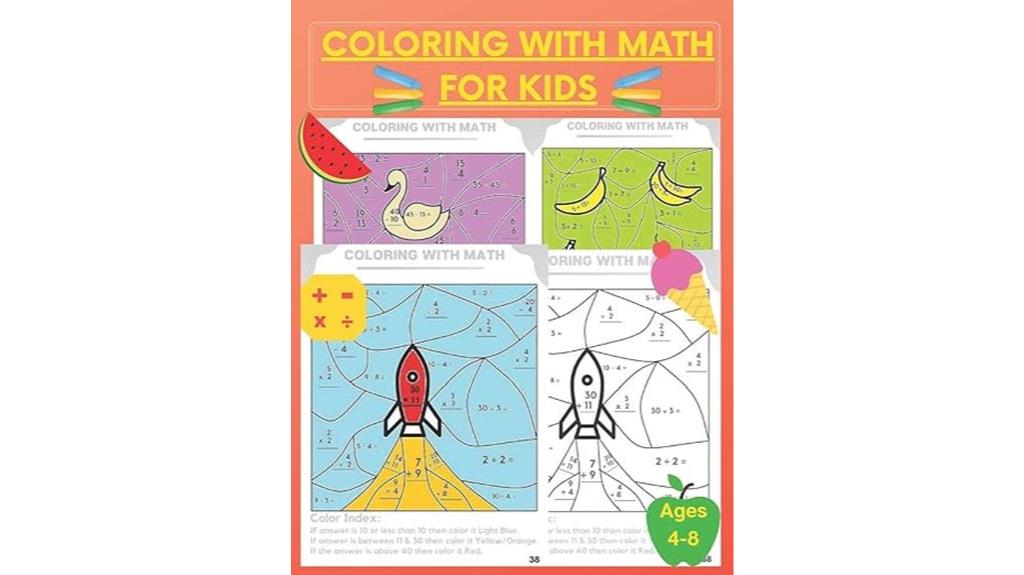
Parents and grandparents seeking a fun, engaging way to help young children develop essential math skills will find Coloring With Math for Kids to be an ideal choice. This activity workbook makes learning addition, subtraction, multiplication, and division enjoyable through creative coloring exercises. Designed for ages 4-8, it offers a playful alternative to traditional drills, boosting confidence while reinforcing key concepts. Kids love coloring math pictures, transforming practice into a fun activity. It’s perfect for outside classroom practice or quiet time at home, helping children build foundational skills in a way that feels like play.
Best For: Parents and grandparents looking for a fun, interactive way to help children aged 4-8 develop essential math skills through engaging coloring activities.
Pros:
- Makes learning math concepts enjoyable and interactive for young children
- Reinforces basic operations like addition, subtraction, multiplication, and division outside the classroom
- Suitable for early learners and provides a creative alternative to traditional drills
Cons:
- May require adult supervision or guidance for some younger children
- Focused primarily on foundational skills, less suitable for advanced math learners
- The coloring format might not appeal to children who prefer more structured or digital learning methods
Factors to Consider When Choosing a Math Art Coloring Book
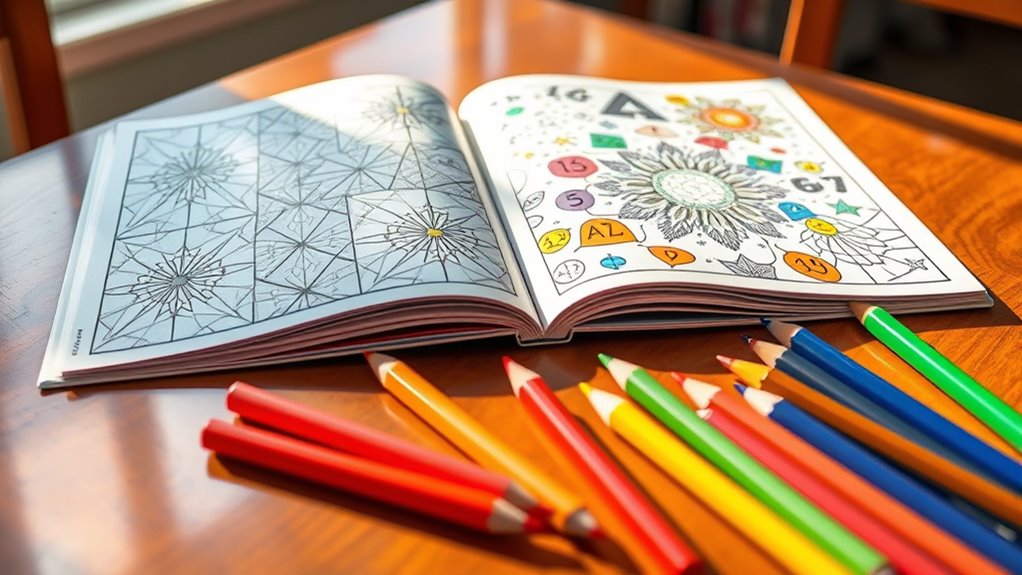
When choosing a math art coloring book, I look for a good mix of artistic styles like geometric, fractal, or tessellations to match different preferences and skill levels. I also consider how well the book explains the math concepts, so I can learn as I color. Finding a balance between engaging designs and educational clarity makes the experience more enjoyable and meaningful.
Factors to Consider When Choosing Math Art Coloring Book
Choosing the right math art coloring book involves more than just picking one with appealing designs; you need to take into account several factors to guarantee it meets your or your child’s needs. First, consider the age and skill level to match the complexity of the patterns and explanations. Next, evaluate the quality of the paper and printing—good quality paper prevents bleed-through and withstands various coloring media. It’s also helpful to find books that blend educational content with artistic inspiration, fostering both understanding and creativity. Check if the book provides additional insights into mathematical concepts, which can deepen learning. Finally, look at the variety and difficulty of the patterns to keep the experience engaging and appropriately challenging, ensuring a rewarding and enjoyable coloring journey.
1. Artistic Style Diversity
A math art coloring book that features a variety of artistic styles can considerably enhance the coloring experience by offering visual diversity. Different styles like geometric, abstract, or nature-inspired patterns appeal to various tastes and keep the activity engaging. When a book includes multiple artistic approaches, it caters to different skill levels and interests, making it more inclusive and stimulating. It also exposes learners to various art techniques and cultural motifs, broadening their understanding of visual diversity. Plus, exploring different styles helps maintain motivation, as users can try new themes and methods, preventing boredom. When choosing a math art coloring book, look for one that offers this range of artistic styles to support creativity, learning, and sustained enjoyment over time.
Look for a Variety of Design Types—Geometric, Fractal, Tessellations—To Suit Different Artistic Preferences and Skill Levels
Exploring a variety of design types in a math art coloring book can considerably enhance your creative experience. When a book offers geometric patterns, fractals, and tessellations, it caters to different artistic tastes and interests. This diversity allows you to progress gradually, starting with simple shapes and moving toward more intricate, detailed designs. Different pattern styles also match varying skill levels, making the book accessible to beginners and challenging enough for advanced colorers. Plus, encountering multiple design genres keeps your engagement high by providing fresh visual experiences and creative challenges. Additionally, exploring these various types helps you understand the mathematical concepts behind the patterns, enriching both your artistic expression and learning journey.
2. Educational Content Depth
When selecting a math art coloring book, it’s important to contemplate how deeply it explores mathematical concepts. Some books offer simple explanations of basic ideas, making them perfect for beginners or younger children. Others include detailed descriptions of complex theories, appealing to older or more advanced learners. Consider whether the book provides supplemental features like explanations, historical context, or real-world applications of the patterns. A deeper educational focus can boost understanding and retention but might require more prior math knowledge. Striking a balance between engaging visuals and educational depth is key—too much detail can overwhelm, while too little may under-inform. Think about your or your child’s interest level and learning needs to find a book that’s both fun and educational without being overwhelming.
Ensure the Book Offers Clear Explanations or Insights Into Mathematical Concepts to Enhance Learning Alongside Coloring
To truly enhance learning through coloring, it’s essential that the book provides clear explanations or insights into the mathematical concepts behind the patterns. Look for titles that include brief, understandable descriptions that connect the artwork to core principles like symmetry, fractals, or geometric shapes. These insights help reinforce what kids are coloring, making the experience both fun and educational. Choose books that combine engaging illustrations with accessible text, so young learners can easily grasp the significance of each pattern. Reflective prompts or questions about the math concepts can deepen understanding and encourage curiosity. Most importantly, guarantee the explanations match the complexity of the designs, offering clarity without overwhelming. This balance makes learning natural and enjoyable, turning coloring into a meaningful educational activity.
Frequently Asked Questions
What Skills Do Math Art Coloring Books Help Develop in Children?
Math art coloring books help children develop their creativity, fine motor skills, and spatial awareness. I’ve seen how they boost problem-solving abilities as kids work through patterns and shapes. They also improve concentration and patience, making learning enjoyable. By combining art and math, children become more engaged and confident, building a strong foundation for future learning. It’s a fun way to make math both accessible and inspiring.
Are These Coloring Books Suitable for Homeschool Learning?
Absolutely, these coloring books are like a secret garden for homeschool learning. They make math tangible and fun, perfectly fitting into a flexible schedule. I’ve used them myself, and my kids love how they turn abstract concepts into vibrant creations. They’re a fantastic way to reinforce lessons, spark creativity, and keep learning engaging. So yes, they’re highly suitable and can easily be integrated into your homeschooling toolkit.
Can Math Art Coloring Books Be Used for Classroom Activities?
Absolutely, I think math art coloring books are perfect for classroom activities. They engage students actively, combining creativity with learning math concepts. I like to incorporate them into lessons to make abstract ideas more tangible and fun. These books encourage collaboration and critical thinking, making math less intimidating. Plus, kids love the colorful, hands-on approach. Overall, they’re a fantastic tool to spice up any math lesson and foster a love for learning.
How Do These Books Support Different Learning Styles?
Think of these books as a treasure chest full of different keys—each catering to a unique learning style. Visual learners thrive with colorful images, kinesthetic learners enjoy hands-on drawing activities, and logical thinkers appreciate the puzzles embedded in the art. I’ve seen how these books adapt, making math accessible and engaging for everyone, turning abstract concepts into vivid, memorable experiences that resonate with each student’s way of learning.
Are There Age-Specific Recommendations for Each Math Art Coloring Book?
Yes, I recommend choosing age-specific math art coloring books to match a child’s development level. For younger kids, look for books with simple shapes and basic math concepts, around ages 3-6. For older children, select books with more complex puzzles and advanced topics, suitable for ages 7-12. This way, they stay engaged and challenged without feeling overwhelmed. Tailoring the books helps make learning both fun and effective.
Conclusion
So, after all this talk about math and art, you’d think the hardest part is choosing the right coloring book. But honestly, it’s amusing how something as simple as a coloring book can turn math into a masterpiece. Who knew that the secret to understanding complex concepts might just be filling in a few happy little shapes? Sometimes, the best way to solve a problem is to color outside the lines.









